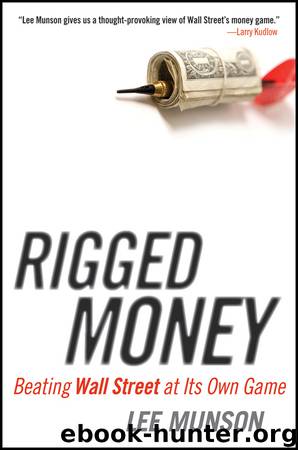Rigged Money by Munson Lee

Author:Munson, Lee
Language: eng
Format: epub
Publisher: John Wiley & Sons
Published: 2011-10-16T16:00:00+00:00
Now that we understand how the mechanics work, we can understand the problems. If HFTs are going to be allowed unparalleled access to the orders coming in, they have to be accountable for the orders they send out. Monitoring trade cancelations versus what they actually execute will keep the system fair. You can’t just sit around and fake out the market with orders you have no intention of filling. Indications of Interest (IOIs) are the other form of gaming that needs to be supervised. Most of the time, an IOI is used to search for natural liquidity. I do this when trolling around dark pools to see if anyone wants to play. However, I intend to trade when the other side is attracted. Part of the problem with HFTs is the use of IOIs when there is no intention of backing up that order. Why is this a problem? Speed. If you have a computer going at light speed putting out IOIs, finding the takers, then pulling back the order instantly, they can bag you and tag you. The point of IOIs is to find people that want to trade with each other without disturbing the market. False IOIs are simply a way to rig the dark pools so traders show their hands, get exposed, then the HFTs can take advantage of the situation. Not cool and not the point of dark pools. There needs to be an obligation if you flash orders or send out IOIs. What institutional investors don’t like is the idea of trading with someone who is trying to take advantage of them. If your broker has superior systems and smart routers, it will take care of itself.
As shown in Figure 6.1, the tip of the iceberg is designed to hide the total size and allow the fast ECNs the ability to slice and dice orders all around the world for the best possible price without disturbing the market. The bogeyman, also known as the nefarious HFT, is out there trying to use an iceberg order to raise the price a few pennies and get out fast. This goes against the concept of keeping prices stable. Long term, the industry has incentives to keep these people out since they ruin the best-price execution. Short term, if you only care about generating commissions, HFTs will work until routers stop hitting your ECN. Thus, it is the ECN that wants to be careful of the bad HFTs, since they are the only people that can root them out.
Figure 6.1 100,000? A Lie!
Download
This site does not store any files on its server. We only index and link to content provided by other sites. Please contact the content providers to delete copyright contents if any and email us, we'll remove relevant links or contents immediately.
The Black Swan by Nassim Nicholas Taleb(6764)
Bad Blood by John Carreyrou(6275)
Pioneering Portfolio Management by David F. Swensen(6079)
Millionaire: The Philanderer, Gambler, and Duelist Who Invented Modern Finance by Janet Gleeson(4094)
Skin in the Game by Nassim Nicholas Taleb(3965)
The Money Culture by Michael Lewis(3846)
Bullshit Jobs by David Graeber(3830)
Skin in the Game: Hidden Asymmetries in Daily Life by Nassim Nicholas Taleb(3723)
The Wisdom of Finance by Mihir Desai(3523)
Blockchain Basics by Daniel Drescher(3329)
Liar's Poker by Michael Lewis(3222)
The Intelligent Investor by Benjamin Graham Jason Zweig(2930)
Hands-On Machine Learning for Algorithmic Trading by Stefan Jansen(2925)
Mastering Bitcoin: Programming the Open Blockchain by Andreas M. Antonopoulos(2891)
Fooled by Randomness: The Hidden Role of Chance in Life and in the Markets by Nassim Nicholas Taleb(2860)
Investing For Dummies by Eric Tyson(2794)
The Power of Broke by Daymond John(2774)
Market Wizards by Jack D. Schwager(2539)
Zero Hour by Harry S. Dent Jr. & Andrew Pancholi(2533)
